ART NEWS:Feb.02
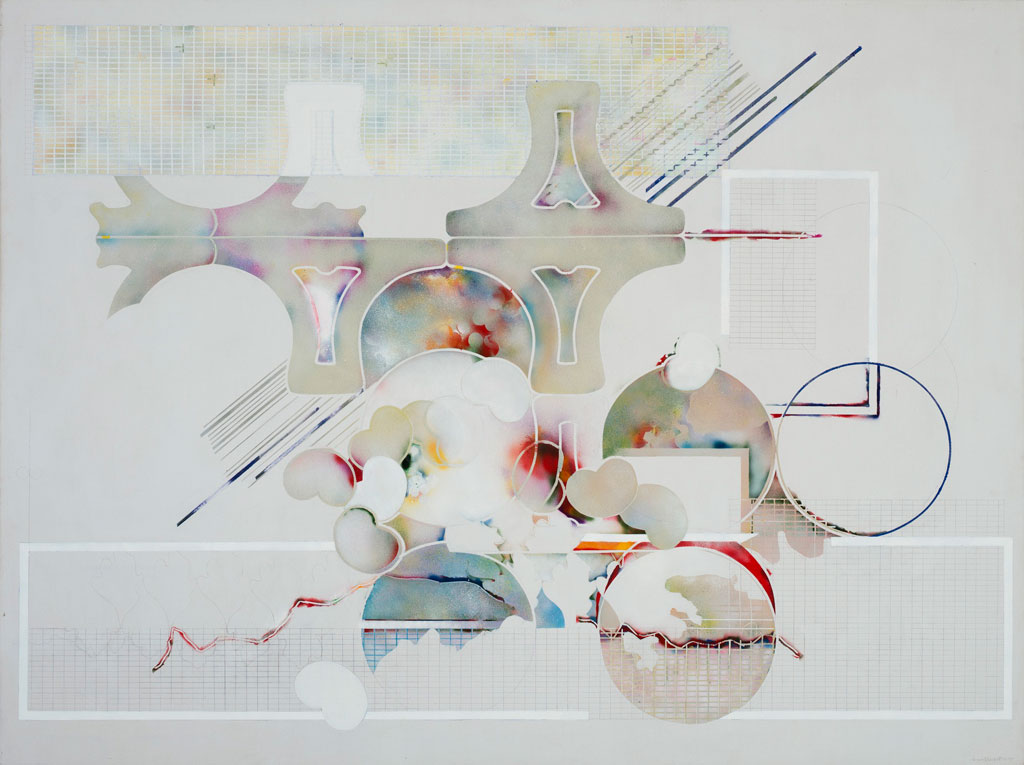 Among the first women to earn an MA in Painting from UC Berkeley in 1949 was Sonya Rapoport. The exhibition “Biorhythm” focuses on a decade of rapid transformation in the artist’s practice (from that first SJMA exhibition to her interactive performances). Charting the transition from abstract painting to computer-based work, the exhibition considers the artist’s prescient exploration of computer-collected and -analyzed personal data and its aesthetic and cultural implications. In 1984 Sonya Rapoport imagined a future fantasy world in which we consult computers to assess how we feel. Using data gathered at her 1983 interactive performance at WORKS/San José, Rapoport created a fictional computer program that could dictate participants’ moods. “Computer Says I Feel . . .” (1984) was the third phase of the multiyear project “Biorhythm” (1980–86), for which she collected and analyzed personal data through both self-assessment and technology-based calculation. Using then-popular biorhythm computers to measure and plot users’ emotional, physical, and intellectual states and comparing the data to personal accounts, including verbal statements made by performance participants and her own diarylike pictorial collages made daily over the course of a year, Rapoport charted the correlation between computed and personal assessment. Her Biorhythm project questions the reflex that cultural theorist Jeanne Randolph described: our primary assumption about technology being that it works. Info: San Jose Museum of Art, 110 South Market Street, San Jose, Duration: 7/2-5/7/20, Days & Hours: Tue-Sun 11:00-17:00, https://sjmusart.org
Among the first women to earn an MA in Painting from UC Berkeley in 1949 was Sonya Rapoport. The exhibition “Biorhythm” focuses on a decade of rapid transformation in the artist’s practice (from that first SJMA exhibition to her interactive performances). Charting the transition from abstract painting to computer-based work, the exhibition considers the artist’s prescient exploration of computer-collected and -analyzed personal data and its aesthetic and cultural implications. In 1984 Sonya Rapoport imagined a future fantasy world in which we consult computers to assess how we feel. Using data gathered at her 1983 interactive performance at WORKS/San José, Rapoport created a fictional computer program that could dictate participants’ moods. “Computer Says I Feel . . .” (1984) was the third phase of the multiyear project “Biorhythm” (1980–86), for which she collected and analyzed personal data through both self-assessment and technology-based calculation. Using then-popular biorhythm computers to measure and plot users’ emotional, physical, and intellectual states and comparing the data to personal accounts, including verbal statements made by performance participants and her own diarylike pictorial collages made daily over the course of a year, Rapoport charted the correlation between computed and personal assessment. Her Biorhythm project questions the reflex that cultural theorist Jeanne Randolph described: our primary assumption about technology being that it works. Info: San Jose Museum of Art, 110 South Market Street, San Jose, Duration: 7/2-5/7/20, Days & Hours: Tue-Sun 11:00-17:00, https://sjmusart.org
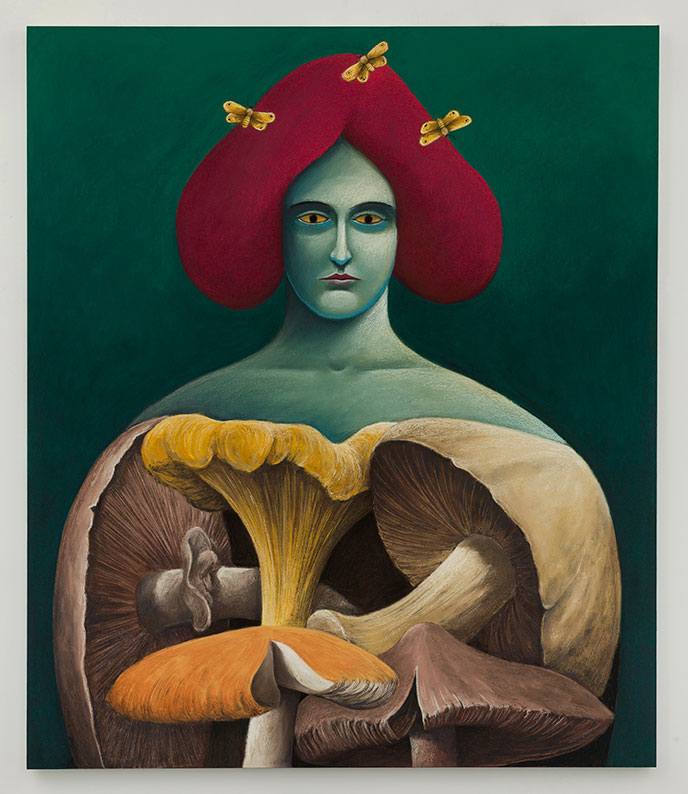 Comprised of new paintings, sculptures, site-specific murals, and an architectural installation, Nicolas Party’s solo exhibition “Sottobosco”, conjures the shadowy world of the forest floor in a brilliant pastel universe where subject, form, and time collapse in visual splendor. Best known for his unique approach to landscapes, portraits, and still life scenes created in pastel, Party directs his idiosyncratic choice of medium toward otherworldly depictions of objects both natural and manmade. The sottobosco still life, made famous by Dutch artist Otto Marseus van Schrieck, is closely tied to scientific developments of the 17h Century Dutch Golden Age, when the invention of the microscope ignited a fascination with all things miniscule. In a latter-day parallel, Nicolas Party’s “Portrait with Mushrooms” (2019) merges his own figure with augmented mushrooms in rich, woody hues, reconsidering sottobosco in a contemporary context. Paintings and sculptures throughout the exhibition depict flora and fauna associated with processes of growth and metamorphosis to suggest themes of evolution as they relate to Party’s own practice and reflections on human history. Info: Hauser & Wirth, South Gallery, 901 East 3rd Street, Los Angeles, Duration: 13/2-12/4/20, Days & Hours: Tue-Sun 11:00-18:00, www.hauserwirth.com
Comprised of new paintings, sculptures, site-specific murals, and an architectural installation, Nicolas Party’s solo exhibition “Sottobosco”, conjures the shadowy world of the forest floor in a brilliant pastel universe where subject, form, and time collapse in visual splendor. Best known for his unique approach to landscapes, portraits, and still life scenes created in pastel, Party directs his idiosyncratic choice of medium toward otherworldly depictions of objects both natural and manmade. The sottobosco still life, made famous by Dutch artist Otto Marseus van Schrieck, is closely tied to scientific developments of the 17h Century Dutch Golden Age, when the invention of the microscope ignited a fascination with all things miniscule. In a latter-day parallel, Nicolas Party’s “Portrait with Mushrooms” (2019) merges his own figure with augmented mushrooms in rich, woody hues, reconsidering sottobosco in a contemporary context. Paintings and sculptures throughout the exhibition depict flora and fauna associated with processes of growth and metamorphosis to suggest themes of evolution as they relate to Party’s own practice and reflections on human history. Info: Hauser & Wirth, South Gallery, 901 East 3rd Street, Los Angeles, Duration: 13/2-12/4/20, Days & Hours: Tue-Sun 11:00-18:00, www.hauserwirth.com
 The exhibition “Pattern-Thinking” at Princeton University, traces Richard Buckminster Fuller’s ambition to measure physical experience into an ever-expanding pattern of relationships and to coordinate these into a conceptual network of words and concepts that shaped the basis for his thinking. The exhibition follows Fuller’s investigations of geometry, structure, language and intellectual property in their relation to design principles and pedagogy, organizing a survey of his work through parallel conceptual threads rather than in a linear chronology. Lines, models, words and concepts emerge as mediums from which to conceive of design as a process of translation, a search for new relationships and generalized principles that can contribute to transdisciplinary knowledge. “Pattern-Thinking” comes in the form of an immersive, inflatable, multimedia sphere occupied by the public and representing three different archives: “Fuller at Princeton”, “Fuller and Design Education”, and “Fuller Today”. It is a contemporary version of Fuller’s “Geoscope” projects built alongside Princeton students during two different teaching appointments in 1953 and 1960. Info: Curator: Daniel López-Pérez, , Princeton University, School of Architecture, Princeton, New Jersey, Duration: 13/2-13/3/20, https://soa.princeton.edu
The exhibition “Pattern-Thinking” at Princeton University, traces Richard Buckminster Fuller’s ambition to measure physical experience into an ever-expanding pattern of relationships and to coordinate these into a conceptual network of words and concepts that shaped the basis for his thinking. The exhibition follows Fuller’s investigations of geometry, structure, language and intellectual property in their relation to design principles and pedagogy, organizing a survey of his work through parallel conceptual threads rather than in a linear chronology. Lines, models, words and concepts emerge as mediums from which to conceive of design as a process of translation, a search for new relationships and generalized principles that can contribute to transdisciplinary knowledge. “Pattern-Thinking” comes in the form of an immersive, inflatable, multimedia sphere occupied by the public and representing three different archives: “Fuller at Princeton”, “Fuller and Design Education”, and “Fuller Today”. It is a contemporary version of Fuller’s “Geoscope” projects built alongside Princeton students during two different teaching appointments in 1953 and 1960. Info: Curator: Daniel López-Pérez, , Princeton University, School of Architecture, Princeton, New Jersey, Duration: 13/2-13/3/20, https://soa.princeton.edu
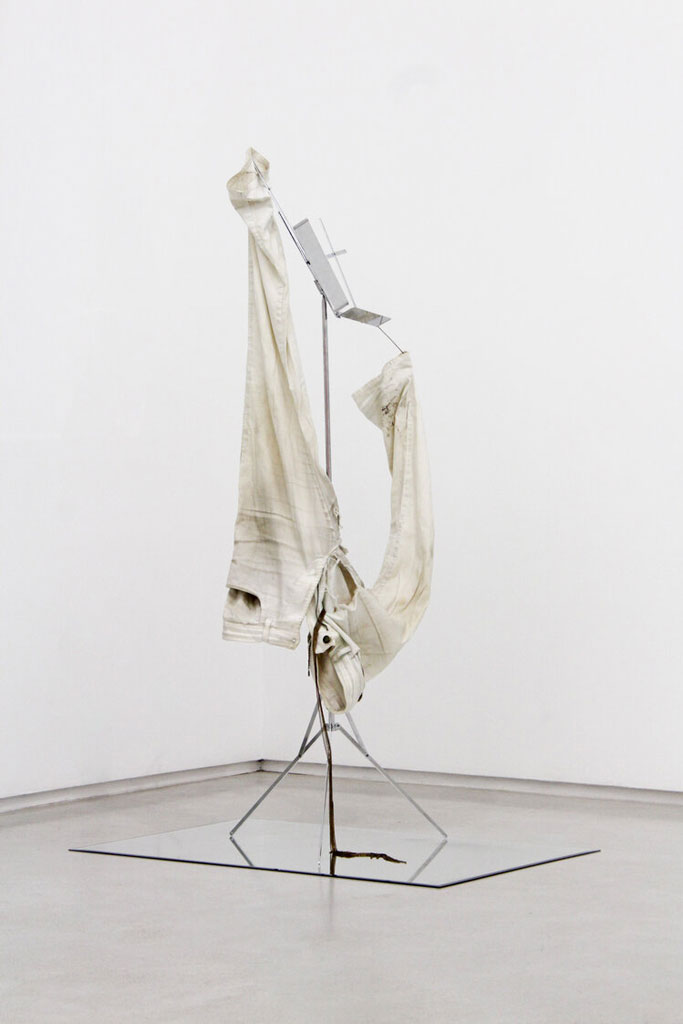 Kayode Ojo in his solo exhibition “Never Been Kissed” presents a series of sculptures, photographs and two new films by the artist that explore the relationship between fashion-exploitation and contemporary culture. Mass produced ready-made objects, staged garments and elements of glamour are configured into sculptures that mimic human proportions and poses. Ojo illustrates the absurdity of the contemporary condition by joining these elements together to demonstrate the complexities of today’s fashion industry and image obsessed culture. Inspired by Hollywood and following the logic of the stage to screen to adaptation, Ojo extends this transference one step further, into an exhibition format. For this exhibition, Ojo considers two Hollywood films incidentally starring Drew Barrymore’s romantic comedy, Never Been Kissed (1994) and the action comedy “Charlie’s Angels: Full Throttle” (2003). In addition to a series of sculptures that recall the world of espionage, Ojo continues to examine visual and cinematic tropes by presenting a new film shot and directed by the artist that touches on his personal connection to the city of Brussels. While playing on this personal narrative through film, he expands even further by exhibiting sculptures inspired by the film “Breakfast at Tiffany’s”, famously starring Audrey Hepburn. Info: Praz-Delavallade, 6150 Wilshire Blvd, Los Angeles, Duration: 14/2-28/3/20, Days & Hours: Tue-Sat 11:00-18:00, www.praz-delavallade.com
Kayode Ojo in his solo exhibition “Never Been Kissed” presents a series of sculptures, photographs and two new films by the artist that explore the relationship between fashion-exploitation and contemporary culture. Mass produced ready-made objects, staged garments and elements of glamour are configured into sculptures that mimic human proportions and poses. Ojo illustrates the absurdity of the contemporary condition by joining these elements together to demonstrate the complexities of today’s fashion industry and image obsessed culture. Inspired by Hollywood and following the logic of the stage to screen to adaptation, Ojo extends this transference one step further, into an exhibition format. For this exhibition, Ojo considers two Hollywood films incidentally starring Drew Barrymore’s romantic comedy, Never Been Kissed (1994) and the action comedy “Charlie’s Angels: Full Throttle” (2003). In addition to a series of sculptures that recall the world of espionage, Ojo continues to examine visual and cinematic tropes by presenting a new film shot and directed by the artist that touches on his personal connection to the city of Brussels. While playing on this personal narrative through film, he expands even further by exhibiting sculptures inspired by the film “Breakfast at Tiffany’s”, famously starring Audrey Hepburn. Info: Praz-Delavallade, 6150 Wilshire Blvd, Los Angeles, Duration: 14/2-28/3/20, Days & Hours: Tue-Sat 11:00-18:00, www.praz-delavallade.com
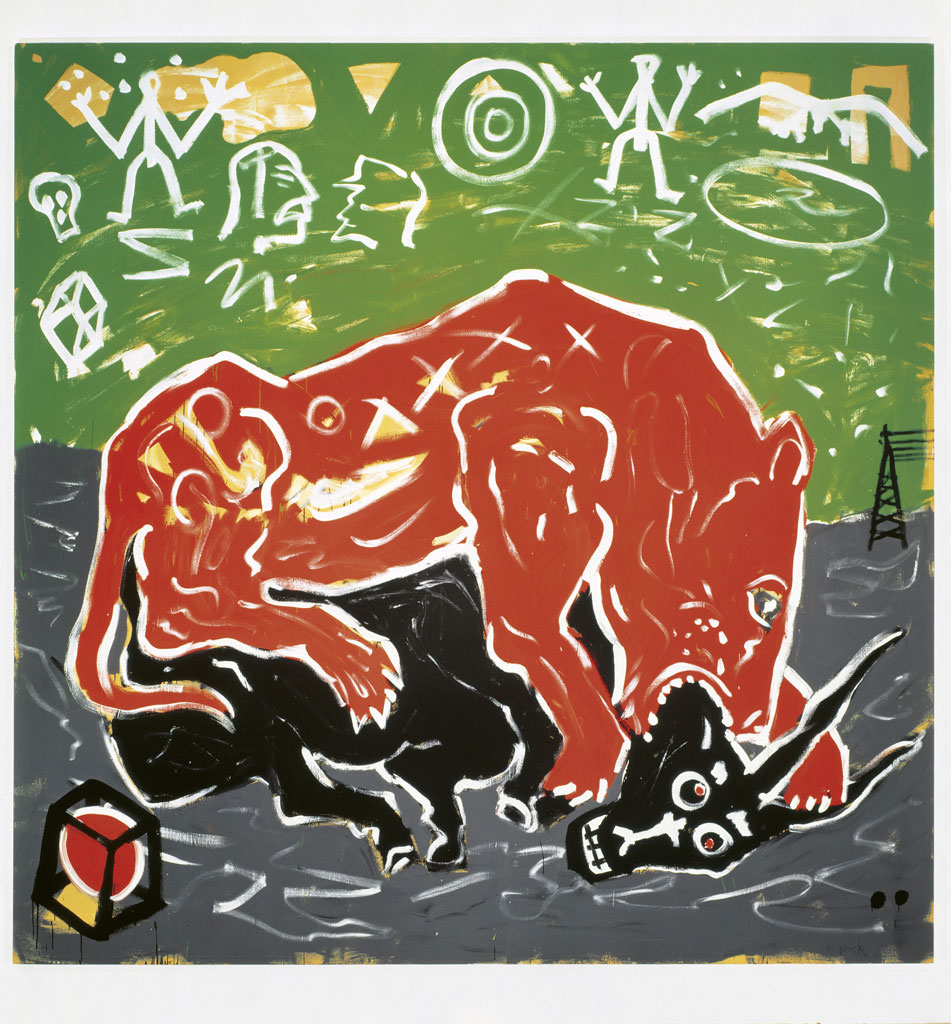 Along with Georg Baselitz, Anselm Kiefer and Markus Lüpertz, A.R. Penck (Ralf Winkler) helped paved the way for a new attitude in art after the Second World War. While many young German artists were opting for an abstract idiom, Penck and the others preferred to depict the visible reality of daily life in work that continued a long European figurative tradition. Wit 200 works the retrospective “A.R. Penck – How It Works” examines how Penck explored the medium of painting throughout his life. He was driven not by any system or rational narrative, but by apparent chaos and emotion. In every drawing and every painting he set out to create a purely visual space where the imagination could thrive and viewers could lose themselves. In the 1960s he developed an idiosyncratic visual idiom consisting of signs and symbols that did not go unnoticed in the west. His fame and appreciation of his work grew after he met the young entrepreneurial Cologne gallery owner Michael Werner in 1965. After he left the GDR in 1980, moving first to Cologne, then to London and Ireland, Penck gained access to all kinds of paint, canvas, board and paper. This led to an explosion of productivity in the 1980s. He also started signing his work with different names, including Mike Hammer, T.M. and Y. Info: Kunstmuseum Den Haag, Stadhouderslaan 41, The Hague, Duration: 15/2-10/5/20, Days & Hours: Tue-Sun 10:00-17:00, www.kunstmuseum.nl
Along with Georg Baselitz, Anselm Kiefer and Markus Lüpertz, A.R. Penck (Ralf Winkler) helped paved the way for a new attitude in art after the Second World War. While many young German artists were opting for an abstract idiom, Penck and the others preferred to depict the visible reality of daily life in work that continued a long European figurative tradition. Wit 200 works the retrospective “A.R. Penck – How It Works” examines how Penck explored the medium of painting throughout his life. He was driven not by any system or rational narrative, but by apparent chaos and emotion. In every drawing and every painting he set out to create a purely visual space where the imagination could thrive and viewers could lose themselves. In the 1960s he developed an idiosyncratic visual idiom consisting of signs and symbols that did not go unnoticed in the west. His fame and appreciation of his work grew after he met the young entrepreneurial Cologne gallery owner Michael Werner in 1965. After he left the GDR in 1980, moving first to Cologne, then to London and Ireland, Penck gained access to all kinds of paint, canvas, board and paper. This led to an explosion of productivity in the 1980s. He also started signing his work with different names, including Mike Hammer, T.M. and Y. Info: Kunstmuseum Den Haag, Stadhouderslaan 41, The Hague, Duration: 15/2-10/5/20, Days & Hours: Tue-Sun 10:00-17:00, www.kunstmuseum.nl
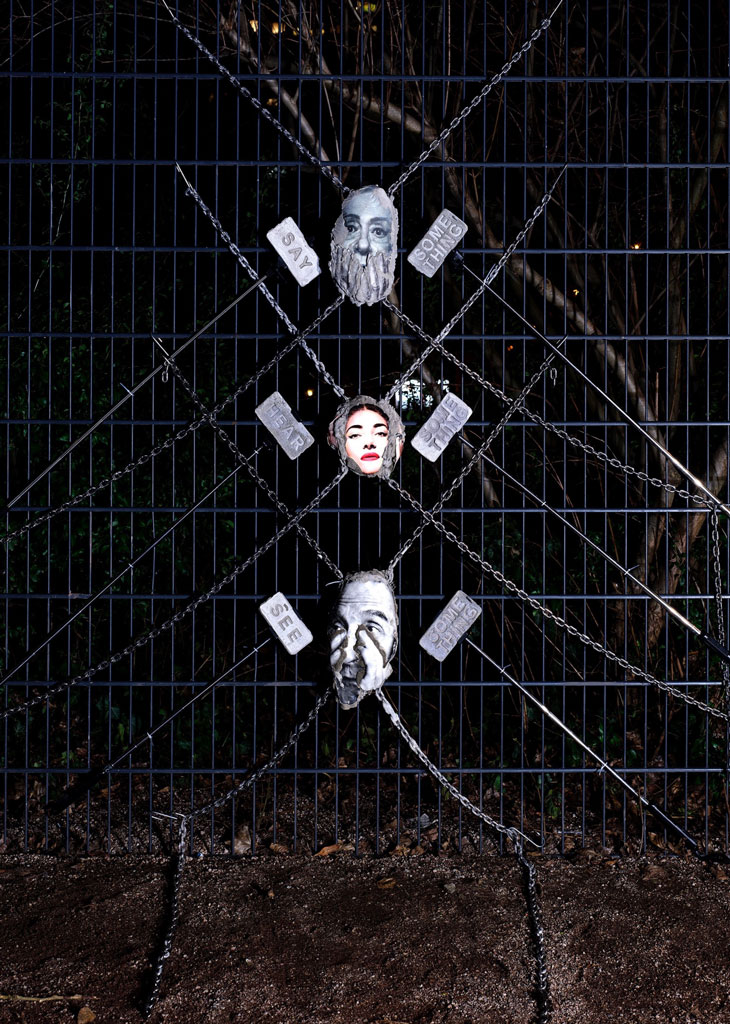 The examination of gesture plays a central role in Matheus Rocha Pitta’s work. As articulations of the body and language, gestures have far-reaching ethical and political implications. Over many years, Rocha Pitta has amassed an extensive archive of news clippings organized by quotidian gestural expression and place of origin. He arranges the material in multi-layered compositions on poured concrete slabs of different sizes and shapes. For his solo exhibition “The Curfew Sirens”, Rocha Pitta has developed an ensemble of new sculptures called Sirens based on gestures of held mouths, ears and eyes. The selected imagery opens up a variety of reference points, including Ulysses’ encounter with the eponymous mythical creatures, the three wise monkeys from a Japanese proverb, and an increasing surveillance mentality in many societies in combination with the urge for constant expression of opinion on social media and the Internet. With the exhibition, Rocha Pitta pursues the question of a possible interruption of the multi-layered chain of power, violence, and language as well as the right to freedom of expression, hate commentaries, and authoritarian control. Info: Curator: Tobias Peper, Kunstverein in Hamburg, Klosterwall 23, Hamburg, Duration: 15/2-17/5/20, Days & Hpurs: Tue-Sun 12:00-18:00, www.kunstverein.de
The examination of gesture plays a central role in Matheus Rocha Pitta’s work. As articulations of the body and language, gestures have far-reaching ethical and political implications. Over many years, Rocha Pitta has amassed an extensive archive of news clippings organized by quotidian gestural expression and place of origin. He arranges the material in multi-layered compositions on poured concrete slabs of different sizes and shapes. For his solo exhibition “The Curfew Sirens”, Rocha Pitta has developed an ensemble of new sculptures called Sirens based on gestures of held mouths, ears and eyes. The selected imagery opens up a variety of reference points, including Ulysses’ encounter with the eponymous mythical creatures, the three wise monkeys from a Japanese proverb, and an increasing surveillance mentality in many societies in combination with the urge for constant expression of opinion on social media and the Internet. With the exhibition, Rocha Pitta pursues the question of a possible interruption of the multi-layered chain of power, violence, and language as well as the right to freedom of expression, hate commentaries, and authoritarian control. Info: Curator: Tobias Peper, Kunstverein in Hamburg, Klosterwall 23, Hamburg, Duration: 15/2-17/5/20, Days & Hpurs: Tue-Sun 12:00-18:00, www.kunstverein.de
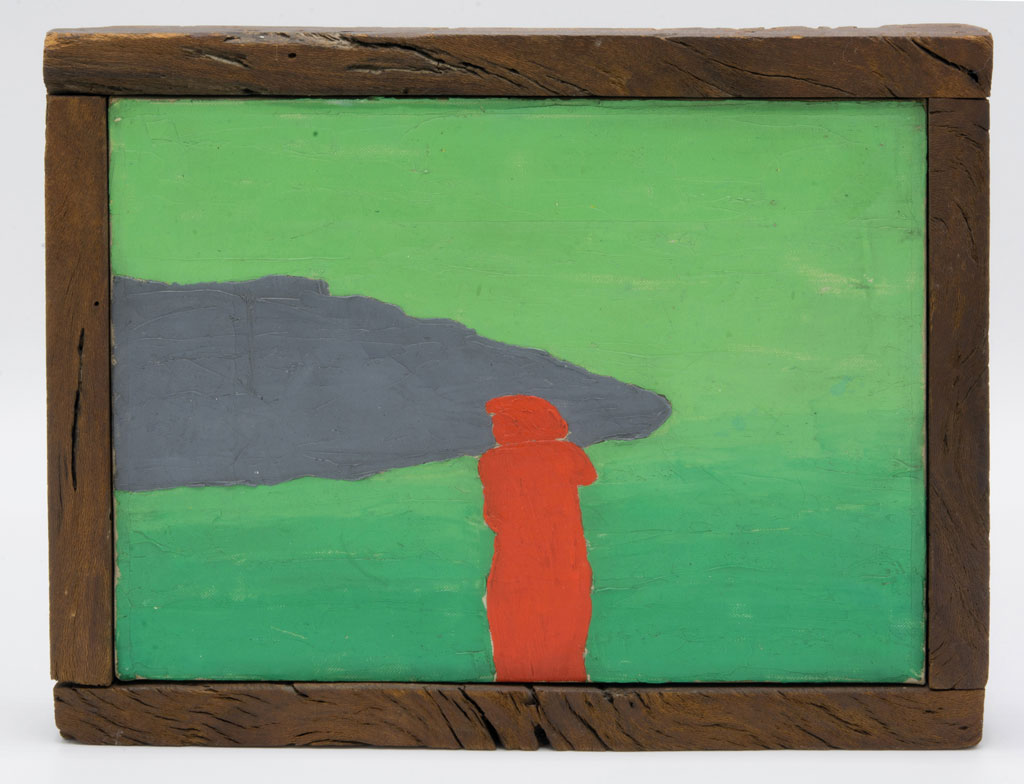 By featuring over seventy works from Institutional and Private Collections, the exhibition with works by Forrest Bess, at the Fridericianum is the first exhibition of the work of American painter in Germany since 1989. The artist’s development is mapped from his early conventional, figurative formulations through to his so-called “visionary” paintings that make up the main body of his work. Furthermore, by exhibiting selected correspondence and other archival material, Bess’s biography is carefully traced while at the same time providing a background to his art theoretical approaches, the handling of his homosexuality, and his theories of hermaphroditism. Forrest Bess is considered an outstanding yet little understood figure in American postwar art. Both his work and lifestyle conformed little to the conventions of the day. He thus led a rather secluded existence from the second half of the 1940s on the Gulf of Mexico where he worked as a catcher and seller of fish bait. During this time, Bess began to systematically produce small-format paintings which encapsulated “visions” that appeared to him on the threshold between waking and sleep. These works, which he exhibited fairly regularly from 1951, feature symbols, shapes, and spaces that are not clearly decipherable and which can be located in the field of biomorphic abstractions. Over time he came to the conclusion that he could attain immortality by uniting the male and the female. In the 1950s this belief ultimately led to personal medical interventions on his own genitals, through which he tried to become a pseudo-hermaphrodite. Info: Fridericianum, Friedrichsplatz 18, Kassel, Duration: 15/2-3/5/20, Days & Hours: Tue-Sun 11:00-18:00, https://fridericianum.org
By featuring over seventy works from Institutional and Private Collections, the exhibition with works by Forrest Bess, at the Fridericianum is the first exhibition of the work of American painter in Germany since 1989. The artist’s development is mapped from his early conventional, figurative formulations through to his so-called “visionary” paintings that make up the main body of his work. Furthermore, by exhibiting selected correspondence and other archival material, Bess’s biography is carefully traced while at the same time providing a background to his art theoretical approaches, the handling of his homosexuality, and his theories of hermaphroditism. Forrest Bess is considered an outstanding yet little understood figure in American postwar art. Both his work and lifestyle conformed little to the conventions of the day. He thus led a rather secluded existence from the second half of the 1940s on the Gulf of Mexico where he worked as a catcher and seller of fish bait. During this time, Bess began to systematically produce small-format paintings which encapsulated “visions” that appeared to him on the threshold between waking and sleep. These works, which he exhibited fairly regularly from 1951, feature symbols, shapes, and spaces that are not clearly decipherable and which can be located in the field of biomorphic abstractions. Over time he came to the conclusion that he could attain immortality by uniting the male and the female. In the 1950s this belief ultimately led to personal medical interventions on his own genitals, through which he tried to become a pseudo-hermaphrodite. Info: Fridericianum, Friedrichsplatz 18, Kassel, Duration: 15/2-3/5/20, Days & Hours: Tue-Sun 11:00-18:00, https://fridericianum.org
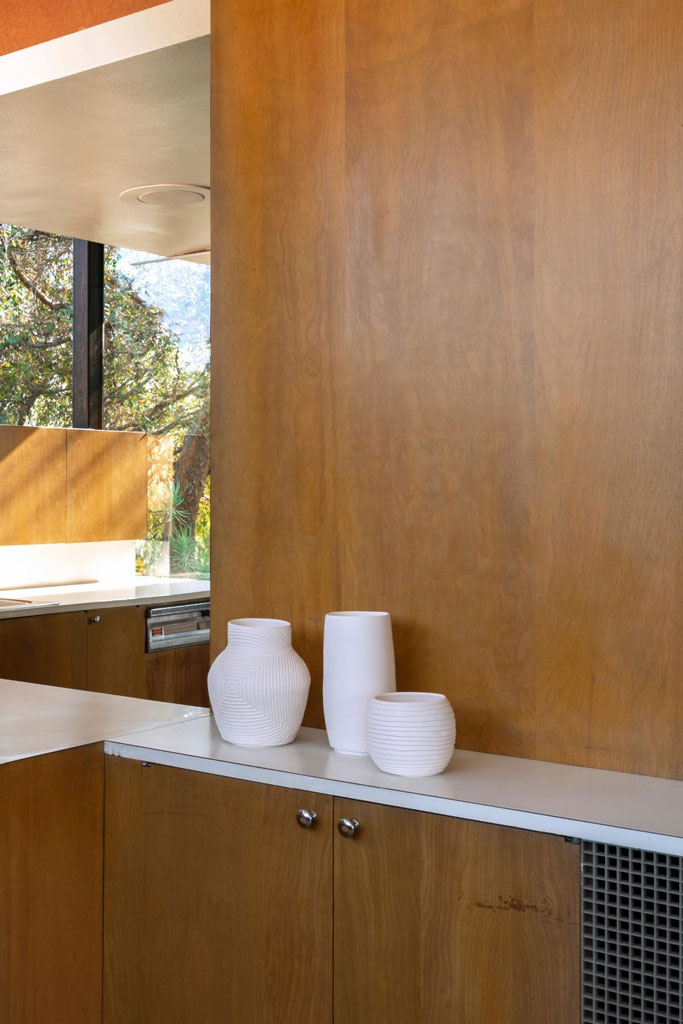 Living and working in Los Angeles for the past two decades, Shio Kusaka has spent her career subtly subverting the world of ceramics within the field of contemporary art. Enthusiastically embracing imperfections and irregularity in her ceramic-based works, Kusaka has approached her practice with a playful openness that is at once modest yet laced with wry humor. Responding to the unique architectural environment of Richard Neutra’s Los Angeles home and workspace, Shio Kusaka quietly populate this iconic example of domestic mid-century modernism with her signature idiosyncratic ceramic vessels, small sculptures of animals, a new set of dinnerware and hand-crafted textile designs inspired by the work of Agnes Martin, Josef Albers and Ellsworth Kelly, respectively. For her installation at the Neutra VDL Studio and Residences Shio Kusaka has given a nod to the phrase “indistinct chatter” that often appears in the subtitles of films and television when voices in the background cannot be identified. Like figures at a cocktail party who quietly chat away in different parts of a home, Kusaka’s pots and sculptures circulate through Neutra’s own domestic environment making their own small talk with both the unique features of the home itself, as well as the visitors to the exhibition. Groups of Kusaka’s older and newly created pots are distributed throughout the shelves, coffee tables and other nooks and crannies of the VDL’s interior. Info: Curators: Douglas Fogle and Hanneke Skerath, Neutra VDL Studio and Residences, 2300 Silver Lake Boulevard, Los Angeles, Duration: 15/2-4/4/20, Days & Hours: Sat 11:00-15:00, www.neutra-vdl.org
Living and working in Los Angeles for the past two decades, Shio Kusaka has spent her career subtly subverting the world of ceramics within the field of contemporary art. Enthusiastically embracing imperfections and irregularity in her ceramic-based works, Kusaka has approached her practice with a playful openness that is at once modest yet laced with wry humor. Responding to the unique architectural environment of Richard Neutra’s Los Angeles home and workspace, Shio Kusaka quietly populate this iconic example of domestic mid-century modernism with her signature idiosyncratic ceramic vessels, small sculptures of animals, a new set of dinnerware and hand-crafted textile designs inspired by the work of Agnes Martin, Josef Albers and Ellsworth Kelly, respectively. For her installation at the Neutra VDL Studio and Residences Shio Kusaka has given a nod to the phrase “indistinct chatter” that often appears in the subtitles of films and television when voices in the background cannot be identified. Like figures at a cocktail party who quietly chat away in different parts of a home, Kusaka’s pots and sculptures circulate through Neutra’s own domestic environment making their own small talk with both the unique features of the home itself, as well as the visitors to the exhibition. Groups of Kusaka’s older and newly created pots are distributed throughout the shelves, coffee tables and other nooks and crannies of the VDL’s interior. Info: Curators: Douglas Fogle and Hanneke Skerath, Neutra VDL Studio and Residences, 2300 Silver Lake Boulevard, Los Angeles, Duration: 15/2-4/4/20, Days & Hours: Sat 11:00-15:00, www.neutra-vdl.org
![]() Leidy Churchman is a painter whose many and various subjects have included landscapes, advertisements, online videos, Tibetan Buddhism, current events, nature photos, scientific diagrams, philosophical concepts, and even the work of other artists. In spite of this seeming all-inclusiveness, however, Churchman’s subjects are conspicuously personal, more like a browser history than an encyclopedia. Churchman has spoken of painting as part of a larger exploration of consciousness, a quest to expand what is knowable. In his solo exhibition “Earth Bound”, the scale of the 16 new paintings, that are on show varies from 26 cm tall abstract composition to an interior scene more than 240 cm wide. One painting depicts the camera lenses of the newest iPhone arranged like three eyes, another a bouquet of roses, while another, based on a Tantric divination card, pictures a cloud-covered Earth from space with a new Earth rising up behind it. One of the paintings in the exhibition depicts a monumental sculpture of a reclining Buddha carved into a granite cliff in Sri Lanka during the twelfth century. Churchman’s painting renders not only the statue’s drapery but also the signage and stanchions added to the site in more recent times. This embrace of the literal and the idealized is a central component of Churchman’s work. Info: Matthew Marks Gallery, 522 West 22 Street, New York, Duration: 21/2-18/4/20, Days & Hours: Tue-Sat 10:00-18:00, www.matthewmarks.com
Leidy Churchman is a painter whose many and various subjects have included landscapes, advertisements, online videos, Tibetan Buddhism, current events, nature photos, scientific diagrams, philosophical concepts, and even the work of other artists. In spite of this seeming all-inclusiveness, however, Churchman’s subjects are conspicuously personal, more like a browser history than an encyclopedia. Churchman has spoken of painting as part of a larger exploration of consciousness, a quest to expand what is knowable. In his solo exhibition “Earth Bound”, the scale of the 16 new paintings, that are on show varies from 26 cm tall abstract composition to an interior scene more than 240 cm wide. One painting depicts the camera lenses of the newest iPhone arranged like three eyes, another a bouquet of roses, while another, based on a Tantric divination card, pictures a cloud-covered Earth from space with a new Earth rising up behind it. One of the paintings in the exhibition depicts a monumental sculpture of a reclining Buddha carved into a granite cliff in Sri Lanka during the twelfth century. Churchman’s painting renders not only the statue’s drapery but also the signage and stanchions added to the site in more recent times. This embrace of the literal and the idealized is a central component of Churchman’s work. Info: Matthew Marks Gallery, 522 West 22 Street, New York, Duration: 21/2-18/4/20, Days & Hours: Tue-Sat 10:00-18:00, www.matthewmarks.com
